Databricks Databricks-Certified-Professional-Data-Engineer Databricks Certified Data Engineer Professional Exam Exam Practice Test
Total 195 questions
Databricks Certified Data Engineer Professional Exam Questions and Answers
To reduce storage and compute costs, the data engineering team has been tasked with curating a series of aggregate tables leveraged by business intelligence dashboards, customer-facing applications, production machine learning models, and ad hoc analytical queries.
The data engineering team has been made aware of new requirements from a customer-facing application, which is the only downstream workload they manage entirely. As a result, an aggregate table used by numerous teams across the organization will need to have a number of fields renamed, and additional fields will also be added.
Which of the solutions addresses the situation while minimally interrupting other teams in the organization without increasing the number of tables that need to be managed?
The following table consists of items found in user carts within an e-commerce website.

The following MERGE statement is used to update this table using an updates view, with schema evaluation enabled on this table.
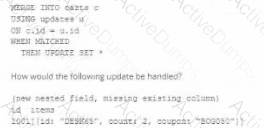
How would the following update be handled?
Which distribution does Databricks support for installing custom Python code packages?
A Databricks SQL dashboard has been configured to monitor the total number of records present in a collection of Delta Lake tables using the following query pattern:
SELECT COUNT (*) FROM table -
Which of the following describes how results are generated each time the dashboard is updated?
A data engineer wants to join a stream of advertisement impressions (when an ad was shown) with another stream of user clicks on advertisements to correlate when impression led to monitizable clicks.

Which solution would improve the performance?
A)

B)

C)

D)

A Structured Streaming job deployed to production has been experiencing delays during peak hours of the day. At present, during normal execution, each microbatch of data is processed in less than 3 seconds. During peak hours of the day, execution time for each microbatch becomes very inconsistent, sometimes exceeding 30 seconds. The streaming write is currently configured with a trigger interval of 10 seconds.
Holding all other variables constant and assuming records need to be processed in less than 10 seconds, which adjustment will meet the requirement?
A Delta Lake table representing metadata about content posts from users has the following schema:
user_id LONG
post_text STRING
post_id STRING
longitude FLOAT
latitude FLOAT
post_time TIMESTAMP
date DATE
Based on the above schema, which column is a good candidate for partitioning the Delta Table?
Incorporating unit tests into a PySpark application requires upfront attention to the design of your jobs, or a potentially significant refactoring of existing code.
Which statement describes a main benefit that offset this additional effort?
A data engineer is performing a join operating to combine values from a static userlookup table with a streaming DataFrame streamingDF.
Which code block attempts to perform an invalid stream-static join?
A nightly job ingests data into a Delta Lake table using the following code:
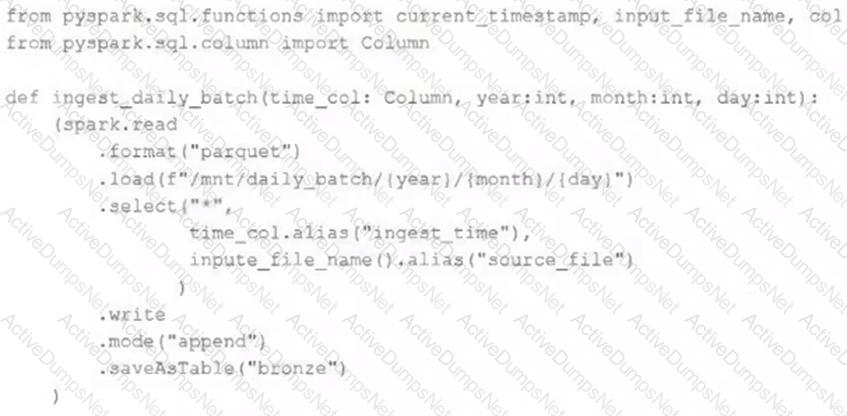
The next step in the pipeline requires a function that returns an object that can be used to manipulate new records that have not yet been processed to the next table in the pipeline.
Which code snippet completes this function definition?
def new_records():
A data pipeline uses Structured Streaming to ingest data from kafka to Delta Lake. Data is being stored in a bronze table, and includes the Kafka_generated timesamp, key, and value. Three months after the pipeline is deployed the data engineering team has noticed some latency issued during certain times of the day.
A senior data engineer updates the Delta Table's schema and ingestion logic to include the current timestamp (as recoded by Apache Spark) as well the Kafka topic and partition. The team plans to use the additional metadata fields to diagnose the transient processing delays:
Which limitation will the team face while diagnosing this problem?
A user new to Databricks is trying to troubleshoot long execution times for some pipeline logic they are working on. Presently, the user is executing code cell-by-cell, using display() calls to confirm code is producing the logically correct results as new transformations are added to an operation. To get a measure of average time to execute, the user is running each cell multiple times interactively.
Which of the following adjustments will get a more accurate measure of how code is likely to perform in production?
A data engineer needs to capture pipeline settings from an existing in the workspace, and use them to create and version a JSON file to create a new pipeline.
Which command should the data engineer enter in a web terminal configured with the Databricks CLI?
The data governance team has instituted a requirement that all tables containing Personal Identifiable Information (PH) must be clearly annotated. This includes adding column comments, table comments, and setting the custom table property "contains_pii" = true.
The following SQL DDL statement is executed to create a new table:

Which command allows manual confirmation that these three requirements have been met?
A developer has successfully configured credential for Databricks Repos and cloned a remote Git repository. Hey don not have privileges to make changes to the main branch, which is the only branch currently visible in their workspace.
Use Response to pull changes from the remote Git repository commit and push changes to a branch that appeared as a changes were pulled.
A user wants to use DLT expectations to validate that a derived table report contains all records from the source, included in the table validation_copy.
The user attempts and fails to accomplish this by adding an expectation to the report table definition.
Which approach would allow using DLT expectations to validate all expected records are present in this table?
Which statement describes Delta Lake Auto Compaction?
A junior data engineer seeks to leverage Delta Lake's Change Data Feed functionality to create a Type 1 table representing all of the values that have ever been valid for all rows in a bronze table created with the property delta.enableChangeDataFeed = true. They plan to execute the following code as a daily job:
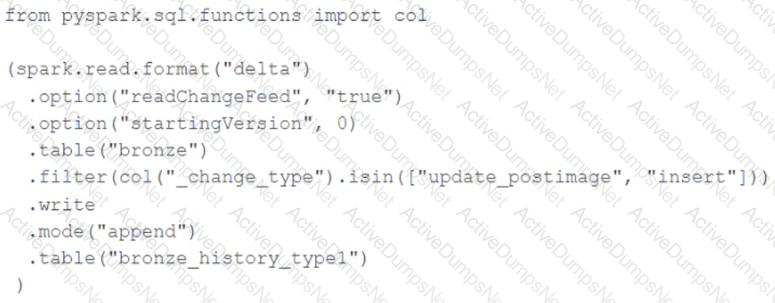
Which statement describes the execution and results of running the above query multiple times?
Which Python variable contains a list of directories to be searched when trying to locate required modules?
A data architect has heard about lake's built-in versioning and time travel capabilities. For auditing purposes they have a requirement to maintain a full of all valid street addresses as they appear in the customers table.
The architect is interested in implementing a Type 1 table, overwriting existing records with new values and relying on Delta Lake time travel to support long-term auditing. A data engineer on the project feels that a Type 2 table will provide better performance and scalability.
Which piece of information is critical to this decision?
A junior data engineer has been asked to develop a streaming data pipeline with a grouped aggregation using DataFrame df. The pipeline needs to calculate the average humidity and average temperature for each non-overlapping five-minute interval. Events are recorded once per minute per device.
df has the following schema: device_id INT, event_time TIMESTAMP, temp FLOAT, humidity FLOAT
Code block:
df.withWatermark("event_time", "10 minutes")
.groupBy(
________,
"device_id"
)
.agg(
avg("temp").alias("avg_temp"),
avg("humidity").alias("avg_humidity")
)
.writeStream
.format("delta")
.saveAsTable("sensor_avg")
Which line of code correctly fills in the blank within the code block to complete this task?
A table is registered with the following code:
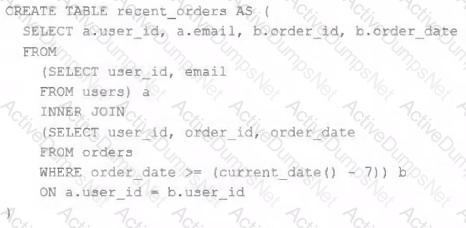
Both users and orders are Delta Lake tables. Which statement describes the results of querying recent_orders?
A data engineer is testing a collection of mathematical functions, one of which calculates the area under a curve as described by another function.
Which kind of the test does the above line exemplify?
The Databricks CLI is use to trigger a run of an existing job by passing the job_id parameter. The response that the job run request has been submitted successfully includes a filed run_id.
Which statement describes what the number alongside this field represents?
A task orchestrator has been configured to run two hourly tasks. First, an outside system writes Parquet data to a directory mounted at /mnt/raw_orders/. After this data is written, a Databricks job containing the following code is executed:
(spark.readStream
.format("parquet")
.load("/mnt/raw_orders/")
.withWatermark("time", "2 hours")
.dropDuplicates(["customer_id", "order_id"])
.writeStream
.trigger(once=True)
.table("orders")
)
Assume that the fields customer_id and order_id serve as a composite key to uniquely identify each order, and that the time field indicates when the record was queued in the source system. If the upstream system is known to occasionally enqueue duplicate entries for a single order hours apart, which statement is correct?
A team of data engineer are adding tables to a DLT pipeline that contain repetitive expectations for many of the same data quality checks.
One member of the team suggests reusing these data quality rules across all tables defined for this pipeline.
What approach would allow them to do this?
The data architect has mandated that all tables in the Lakehouse should be configured as external Delta Lake tables.
Which approach will ensure that this requirement is met?
Which statement describes the default execution mode for Databricks Auto Loader?
A transactions table has been liquid clustered on the columns product_id, user_id, and event_date.
Which operation lacks support for cluster on write?
A junior data engineer is working to implement logic for a Lakehouse table named silver_device_recordings. The source data contains 100 unique fields in a highly nested JSON structure.
The silver_device_recordings table will be used downstream for highly selective joins on a number of fields, and will also be leveraged by the machine learning team to filter on a handful of relevant fields, in total, 15 fields have been identified that will often be used for filter and join logic.
The data engineer is trying to determine the best approach for dealing with these nested fields before declaring the table schema.
Which of the following accurately presents information about Delta Lake and Databricks that may Impact their decision-making process?
The data engineering team is migrating an enterprise system with thousands of tables and views into the Lakehouse. They plan to implement the target architecture using a series of bronze, silver, and gold tables. Bronze tables will almost exclusively be used by production data engineering workloads, while silver tables will be used to support both data engineering and machine learning workloads. Gold tables will largely serve business intelligence and reporting purposes. While personal identifying information (PII) exists in all tiers of data, pseudonymization and anonymization rules are in place for all data at the silver and gold levels.
The organization is interested in reducing security concerns while maximizing the ability to collaborate across diverse teams.
Which statement exemplifies best practices for implementing this system?
In order to facilitate near real-time workloads, a data engineer is creating a helper function to leverage the schema detection and evolution functionality of Databricks Auto Loader. The desired function will automatically detect the schema of the source directly, incrementally process JSON files as they arrive in a source directory, and automatically evolve the schema of the table when new fields are detected.
The function is displayed below with a blank:
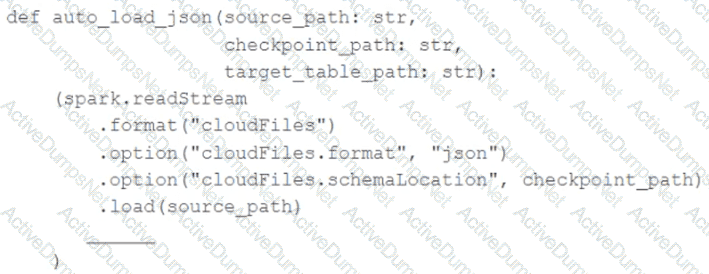
Which response correctly fills in the blank to meet the specified requirements?
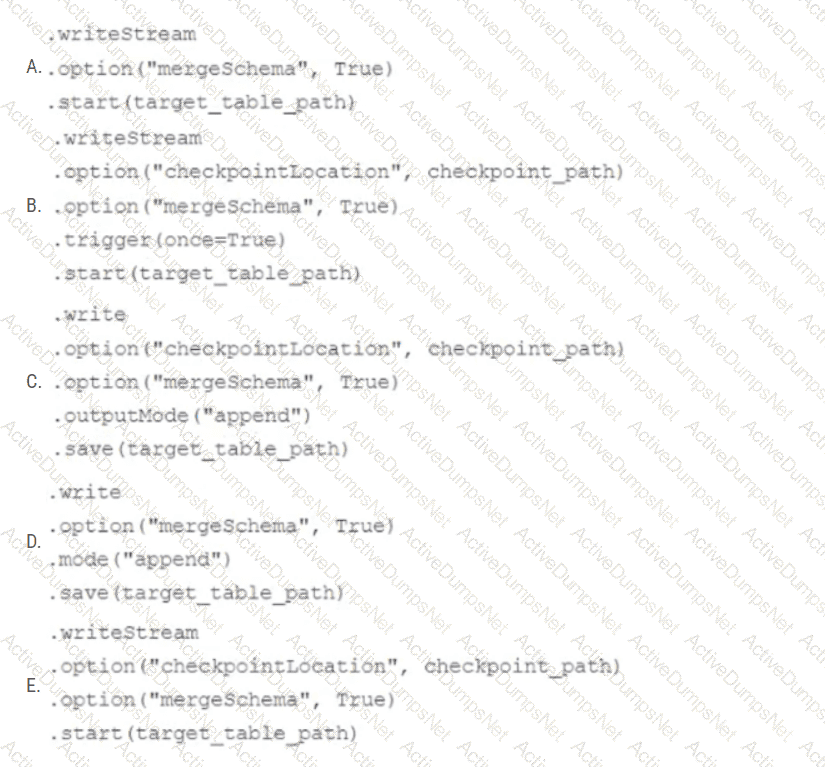
A data engineer wants to reflector the following DLT code, which includes multiple definition with very similar code:
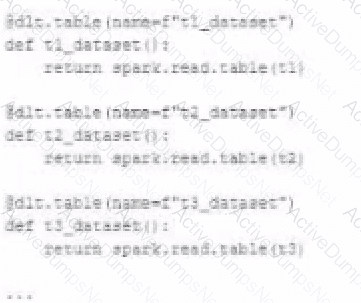
In an attempt to programmatically create these tables using a parameterized table definition, the data engineer writes the following code.

The pipeline runs an update with this refactored code, but generates a different DAG showing incorrect configuration values for tables.
How can the data engineer fix this?
A Spark job is taking longer than expected. Using the Spark UI, a data engineer notes that the Min, Median, and Max Durations for tasks in a particular stage show the minimum and median time to complete a task as roughly the same, but the max duration for a task to be roughly 100 times as long as the minimum.
Which situation is causing increased duration of the overall job?
Which of the following is true of Delta Lake and the Lakehouse?
A junior data engineer has configured a workload that posts the following JSON to the Databricks REST API endpoint 2.0/jobs/create.
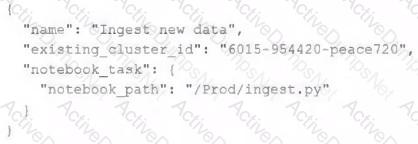
Assuming that all configurations and referenced resources are available, which statement describes the result of executing this workload three times?
When scheduling Structured Streaming jobs for production, which configuration automatically recovers from query failures and keeps costs low?
What is the first of a Databricks Python notebook when viewed in a text editor?
The data engineer team is configuring environment for development testing, and production before beginning migration on a new data pipeline. The team requires extensive testing on both the code and data resulting from code execution, and the team want to develop and test against similar production data as possible.
A junior data engineer suggests that production data can be mounted to the development testing environments, allowing pre production code to execute against production data. Because all users have
Admin privileges in the development environment, the junior data engineer has offered to configure permissions and mount this data for the team.
Which statement captures best practices for this situation?
Which of the following technologies can be used to identify key areas of text when parsing Spark Driver log4j output?
Total 195 questions


